Green Samsung 18650 25R5 vs. Blue 25R2 June 09 2015, 14 Comments

Battery Bro was asked for clarification to distinguish between the blue 25R and the green 25R.
When requested, Samsung SDI responded with the following model names:
- Blue model: Samsung 25R2
- Green model: Samsung 25R5
What is the difference between the blue and green Samsung 25R 18650?
They sent a scanned letter-of-guarantee for the new Samsung 25R5. Here are the pertinent parts transcribed:
Bottom-line: The green 25R5 has a better cycle life.
A cycle is one full charge and discharge of the battery. If someone asked you how old a battery is, you should answer by telling its cycle count. So what is the cycle life the 25R? A quick check of the spec sheet yields the answer:
The 25R2's life is: 250 cycles. This is tested at 20A, the cell's max. continuous discharge rating.
After 250 cycles the maximum capacity the 25R2 can hold dips to 1500mAh or lower (this is at 60% of its starting capacity, at 25℃).
So we can say that the 25R5 has a cycle life greater than 250 under these same conditions.
A closer look at the chemical changes that go in to the Samsung 25R5.
Samsung listed three different chemical tweaks for the 25R5 - FEC, SN, and PA77.
FEC: Fluoroethylene Carbonate
- Samsung 18650 25R2 (blue): 3%
- Samsung 18650 25R5: (green): 5%
This paper published in 2011 by the American Chemical Society describes the effect of FEC on battery performance in lithium-ion battery electrolyte compositions.
When batteries are cycled there are a small impurities, that over time reduce the capacity of the cell. This is why batteries do not last forever.
Every time you charge or discharge your 18650 battery (cycling), you are destroying nanoscopic structures that store bits of energy.

In this image you can see the structural and performance differences to an electrolyte with FEC added. The red (b) and green (c) lines include FEC, their lines never dip below a 1000mAh capacity, and the photos show materials which are structurally more complicated and precise. The black (a) line is nearly depleted by cycle 35.
Scientists look at the different morphologies of the battery chemistry with images like these. For fun, see if you can identify any of the following traits in the image:
- nanofibers
- nanotubes
- nanowalls
- nanocones
- nanoflakes
- nanoshafts
In this paper, scientists created NiO (nickel oxide - a transition-metal) which is nancuboid (small, cube-shaped). The nice clean and sharp edges that make up the nickel oxide cubes are interesting because they are able to discharge energy at a high rate (high amp charge/discharge), and also store a lot of energy (high capacity). They applied FEC (fluoroethylene carbonate) as an additive to the cubed nickel oxide, which produced better cycling stability.

Some seriously awesome nano cuboids are shown here. These two images courtesy of the paper linked to earlier.
The FEC addition gives the nano-cuboids better performance, and the degradation caused by cycling your battery is lessened. They found NiO is relatively stable until its 35th cycle ,where a sharp drop in capacity is observed. The drop is attributed to the degradation of the NiO - particularly it undergoes a reaction that features large volume changes which cause cracks, reduce conductivity, and pulverize the electrode. When an FEC additive was introduced, great improvements to capacity were observed: the measurement being almost twice the theoretical capacity of NiO. The changes are attributed to nanoscopic morphologies but the precise reasoning is not well known.
Bottom-line: Adding FEC increases the cycle life of li-ion batteries.
SN: Succinonitrile
- Samsung 18650 25R2 (blue): 1.5%
- Samsung 18650 25R5: (green): 1.0%
This paper from 2014 describes the effect on a cell’s impedance (a measurement of resistance) when the electrolyte includes an SN (succinonitrile) additive.
In summary, adding SN to the electrolyte greatly increased the impedance (resistance) growth during cycling. As lithium-ion batteries age, not only does capacity go down, but internal resistance goes up. This makes it more difficult for lithium-ions to flow, and places added stress on the battery causing further degradation.
So the SN electrolyte actually increases battery resistance between cycles. By reducing the amount of SN in the Samsung 25R5, Samsung SDI has also decreased the 25R’s impedance growth.
Bottom-line: Decreasing SD will keeping resistance low, for longer.
PA77: Unknown
- Samsung 18650 25R2 (blue): 1.0%
- Samsung 18650 25R5: (green): 1.5%
Actually I can find no information about this additive in an electrolyte, so I think it is probably Samsung SDI proprietary research. They have increased the balance of the PA77 chemical in the 25R5 electrolyte, and I assume it improves cycle life in some way but I don’t know how.
Could the secret of the green 25R5 be... protactinium?
PA (protactinium) is very toxic and a highly radioactive chemical element, but is present in small amounts in most natural things. We eat it, drink it, and breath it. Government even regulates the amount of allowed PA in the atmosphere. Samsung SDI stated “PA77” as the chemical in the letter-of-guarantee, where normally the ‘77’ should denote the element’s isotope number. It is possible Samsung uses a special isotope of protactinium which is very stable called protactinium-77.
But there is no indication of this, anywhere.
Argonne National Lab, holds thousands of lithium-ion patents. They have invented some of the most widely used 18650 chemistries like NCR, and lease them out to others like Panasonic. Owing to the chemical protactinium's scarcity, high radioactivity, and high toxicity Argonne Labs stated in 2005 that PA has no use outside of scientific research.
So has Argonne started putting it in batteries since then?
It’s possible because I can’t think of what else the PA77 would refer to. If it followed the same naming convention as the other two chemical changes, all roads lead to this conclusion. However it may very well be something completely different. If you are a chemist or battery scientist that has a different idea, please send me a message! I would love to get to the bottom of this.
A reader has pointed out that there is no way protactinium could be in the battery. This makes sense to me, but also it means I have no clue what PA77 might refer to.
Bottom-line: I don’t know what PA77 is.
Doing some capacity tests on the Samsung 25R5 (green)
Samsung guarantees performance will be identical to the 25R, so I ran some discharge tests earlier to verify their statement as part of our supply-chain inspection process .
My testing environment is good and conditions here match Samsung's testing requirements of:
- Unless otherwise specified, all tests stated in this specification are conducted at temperature 25±5℃ and humidity 65±20%.
- The amp-meter and volt-meter should have an accuracy of the grade 0.5mA and mV or higher.
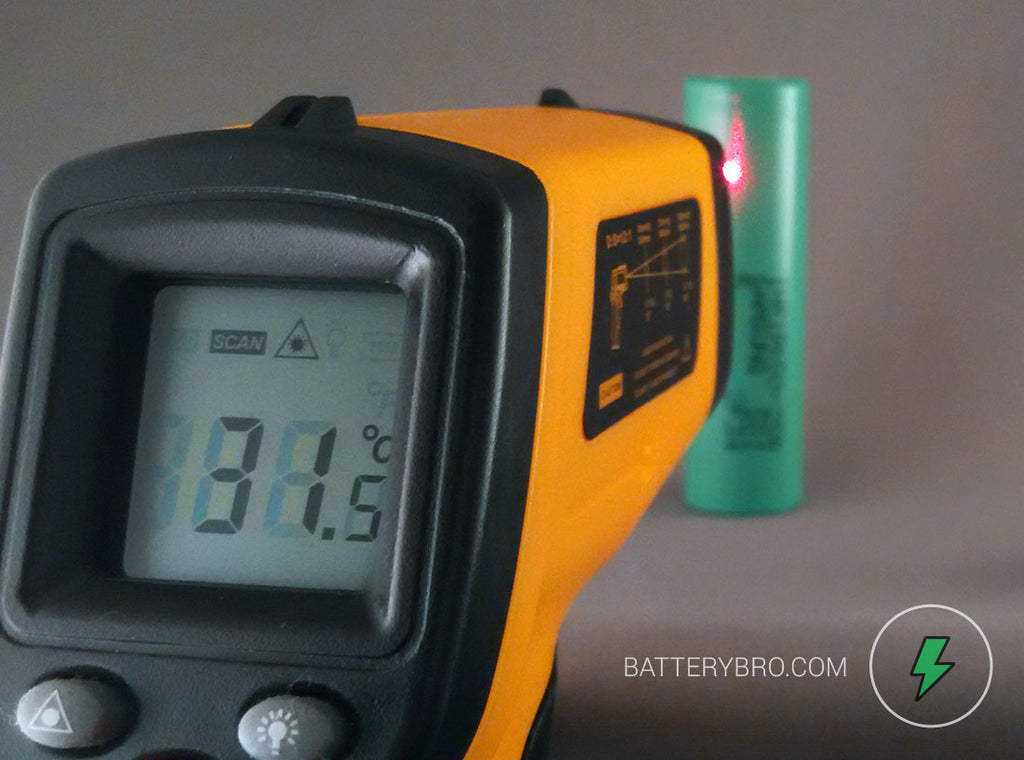
Actually we are exactly 30 degrees, the 1.5 degree extra is coming from the photo lamps.
Before the discharge tests I had to charge up the cells. Samsung stores the 25R at 50 ±5% charged state (from 3.640V to 3.710V). When I received them that was the case according to my Soshine charger - indicative of brand new cells.
The first two tests I ran are at a continuous discharge of 2.5A - which is our standard here for discharge tests as this is the upper limit of what a USB drive can provide for power, and we graph via USB for speed.
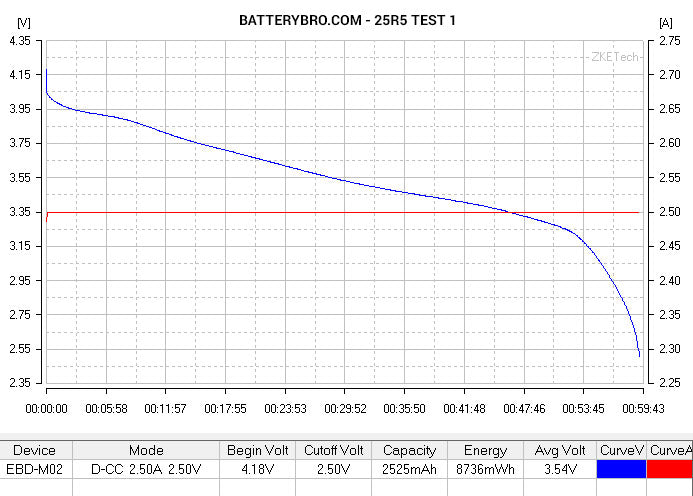

Very nice! The cell easily exceed manufacturer specs - being able to provide more capacity than rated, at a higher discharge current than tested for.
The third test is run to compare more closely manufacturer specs. The Samsung 25R is officially discharged at .2C or .50 amps to achieve its rated capacity. This is low, as most 25R use is maximizing its max. continuous discharge rating of 20A. But that is how all 18650 cells are rated for capacity, at a minimum viable drain. The more amps you draw, the less total capacity generally is available. This is called a loss of efficiency, and the efficiency lost from high-drain scenarios ranged between different chemical makeups.
Here is the Samsung 25R2 at .50A:

Take a look, it's interesting. At .50A the resolution of the discharge curve becomes more detailed. You can see three different peaks in voltage. Each one of these voltage peaks is accounted for by a chemical change inside the battery.
You may have noticed the capacity stayed the same, but the total energy increased.
How can this be?
By overlaying the graphs we can clearly see where the difference is:
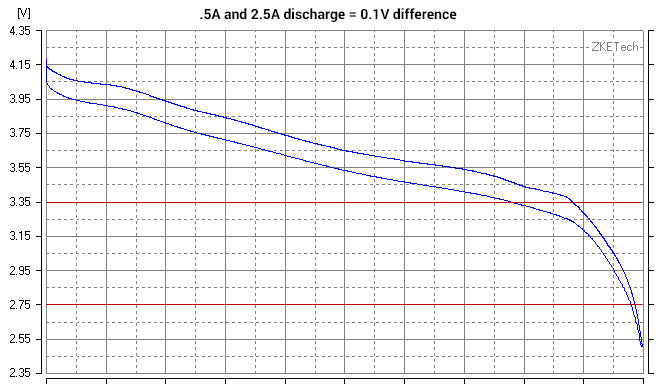
A 0.10 volt difference between the discharges.
And this everybody, is exactly why capacity ratings can be misleading. Both discharges started, and ended at exactly the same time. They followed the same path, except the 0.50A discharge stayed 0.10V higher than the 2.5A-discharge. The same amps, for the same amount of time, albeit at a different voltage is in turn a higher total energy.
Analogy: Imagine a sink and a beaker. The beaker is very long and very thin - like an elongated pencil. You want to fill it up using the faucet. But every drop of water wasted is valuable energy lost. If you turn the sink on full-force you will fill up the beaker quickly, but water will splash and many drops will escape. So what do you do? You bring the faucet down to a drip, and you can actually catch all the water.
Most batteries do lose capacity when they are discharged with a higher current. The fact that the 25R5 loses no capacity between a .50A and 2.5A discharge is an excellent trait. Older battery chemistries (just a few years ago) were not this efficient.
The performance of the 25R5 is really outstanding.
Difference between the 25R2 and 25R5

A typical discharge test for a 25R2 (with same conditions as 25R5 test 1 & 2).
As Samsung SDI originally stated, the main difference between the blue Samsung 25R and the green Samsung 25R is the increased cycle life. A small capacity gain, or efficiency gain may be a side-effect of improved chemistry (the 25R5 has two years of research over the 25R2 so it's not so far-fetched).
Visual Inspection

The green Samsung 18650 25R we have have been talking about in all its glory. Let's go through a quick check list:
- Scratches: None
- Rust: None
- Discoloration: None
- Leakage: None
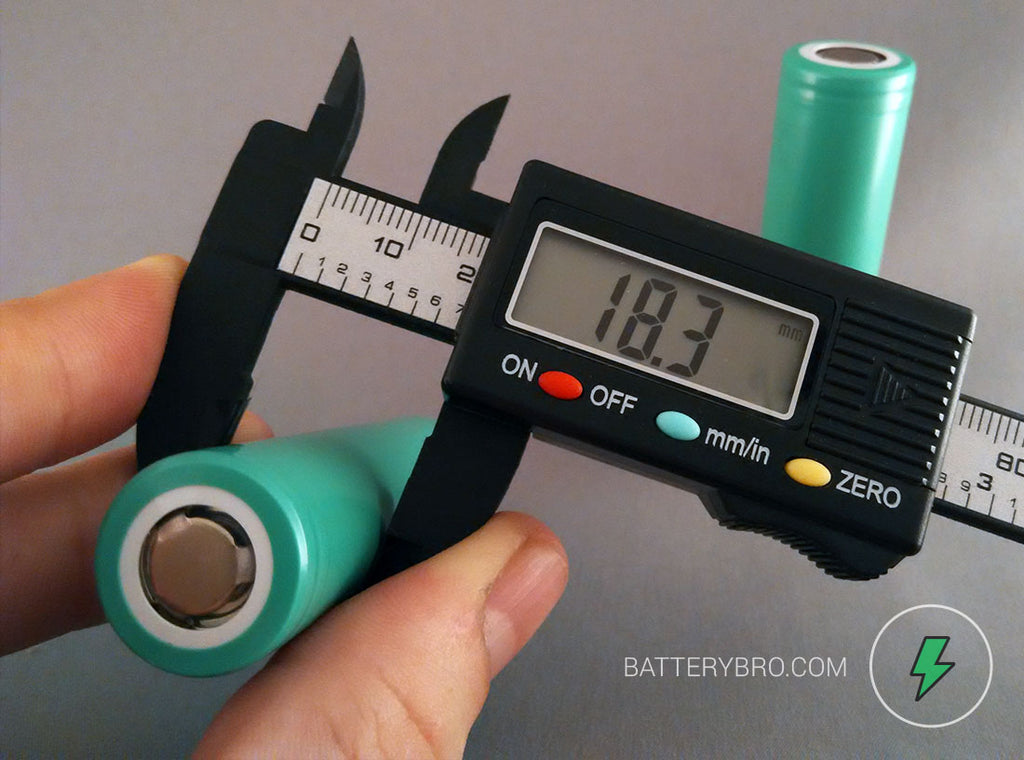
The diameter is 18.3mm, check.
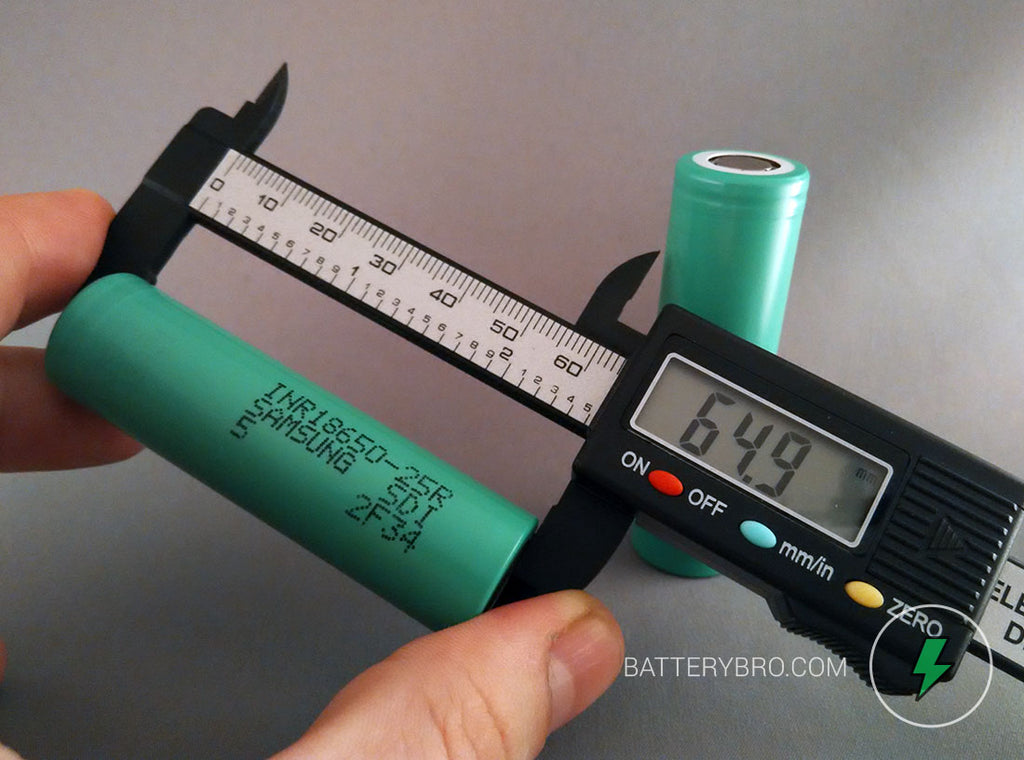
The height is 64.9mm, check.
IMPORTANT: Digital calipers are recommended by Samsung for this test - but you must remember not to use metal calipers as they may short-circuit your cell.
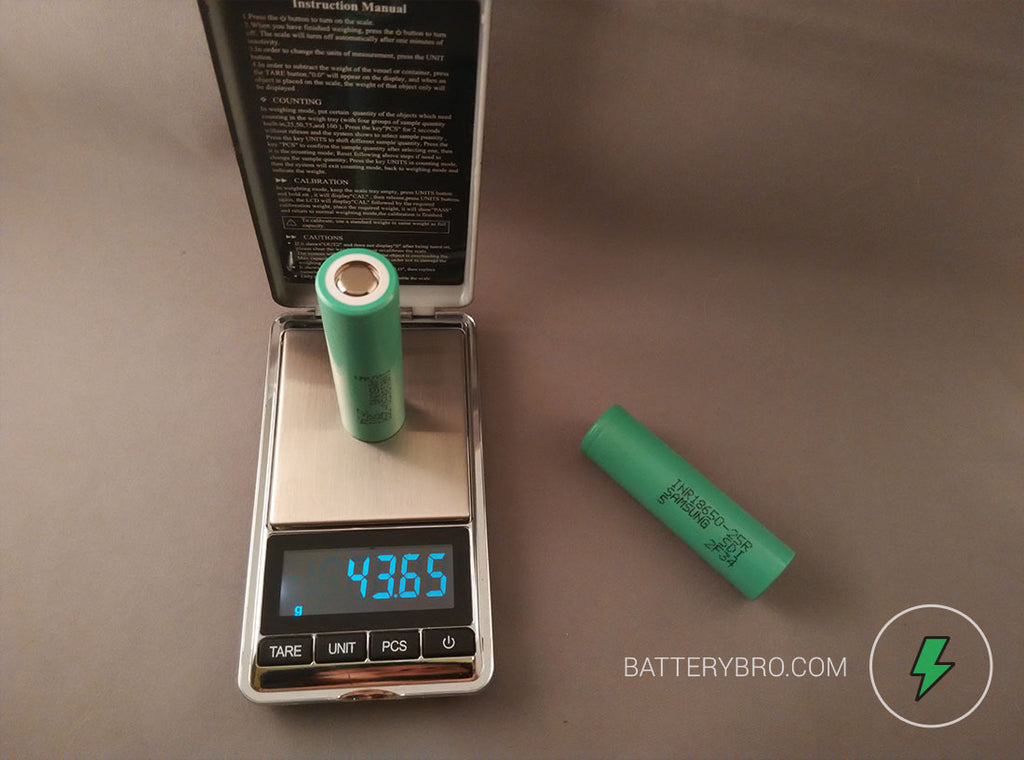
I weighed both batteries, they are identical in weight which is very nice to see. Actually I fully charged one, and fully discharged the other because I wanted to see if there would be a weight difference. Just to be clear, I theorized no difference... and it does turn out the case is that there is no difference.

You may recall from the previous post about the Samsung 25R, that all Samsung top caps have three connection points.
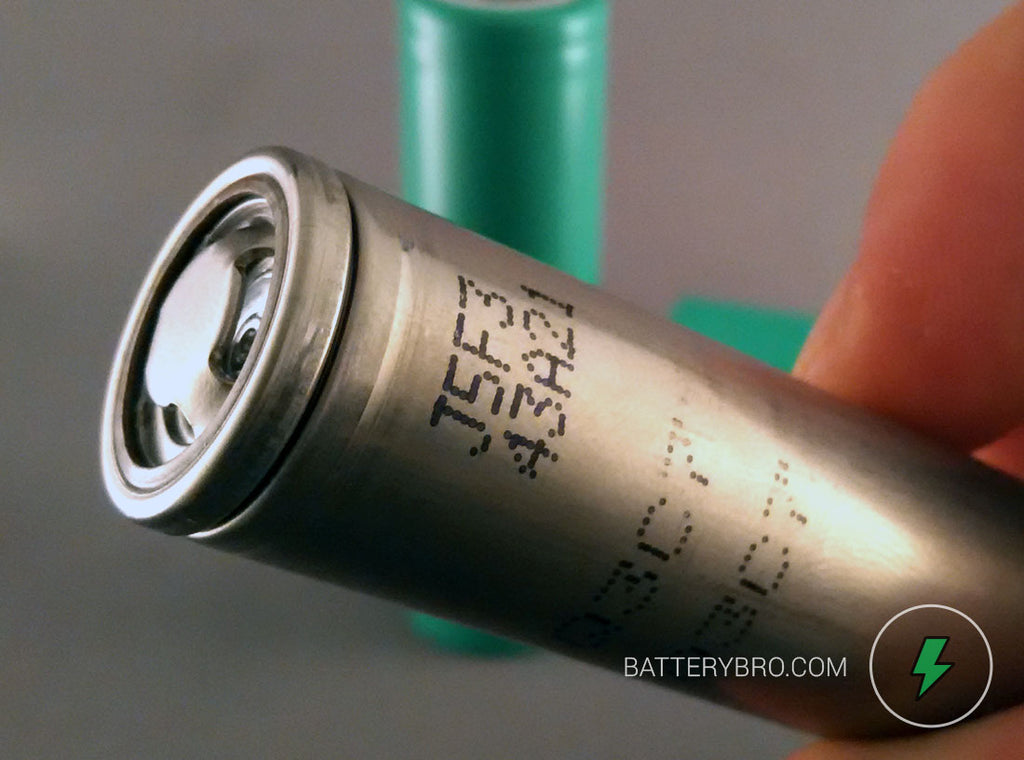
I took the PVC off this one. These quality control markings can be seen through the PVC with a keen eye.
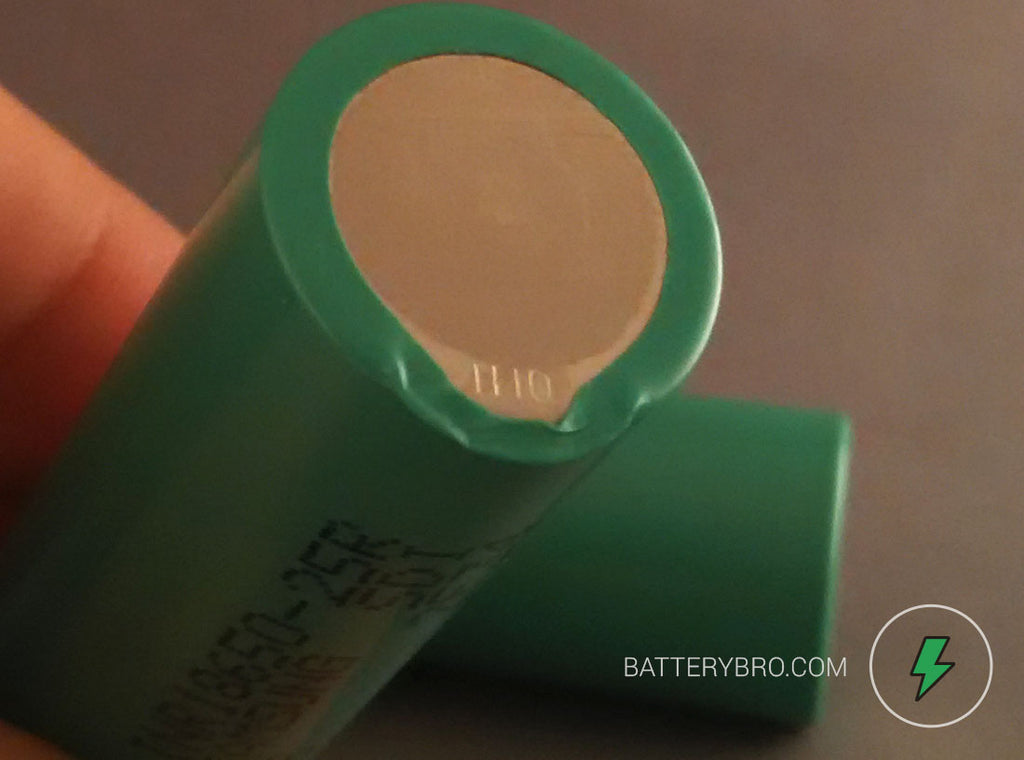
The most unique external characteristic of the 25R2 and the 25R5 are the etchings in bottom of the negative terminal of the battery. This battery has an 'H10', and I had to peel back the PVC somewhat to see it. No other 18650 battery series I've seen except the 25R has this (but that may be because I haven't seen enough).
Compare to the blue Samsung 25R
Take a look at previous posts we did on the blue 25R2:
Is it a fake Samsung 18650 25R?
Awesome batteries - the Samsung 25R
Thanks for reading!


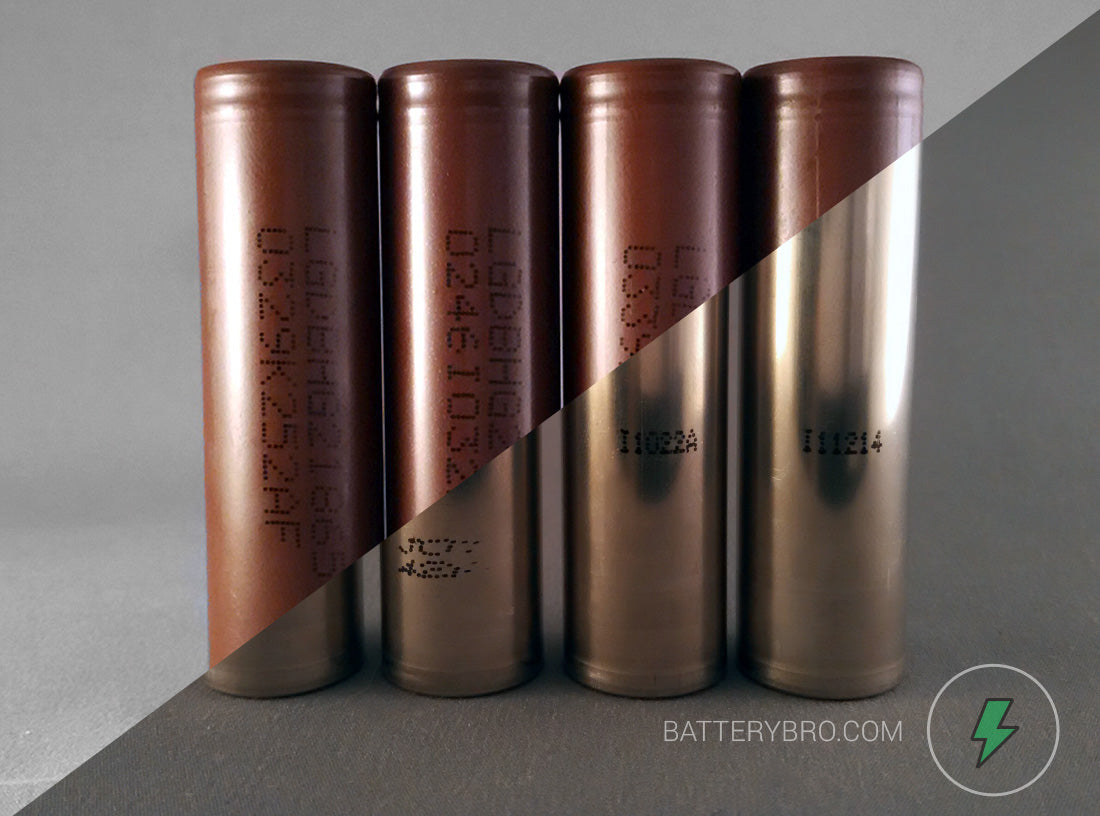

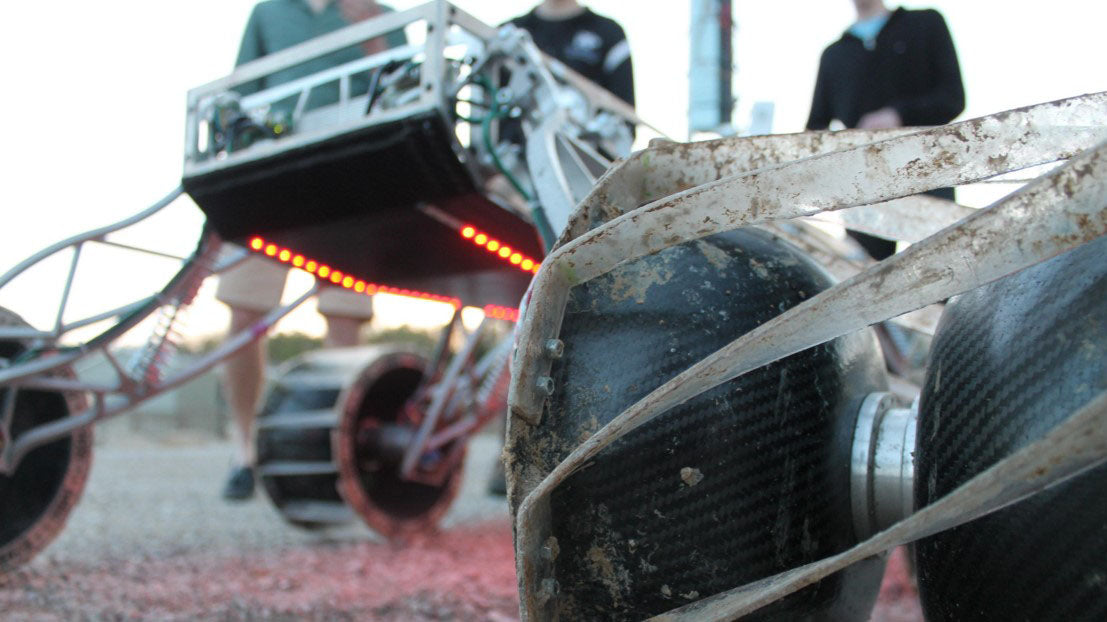



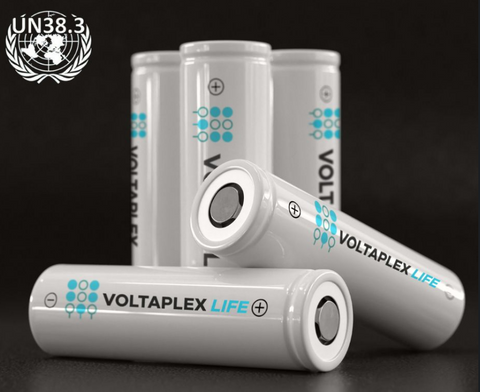

Comments
Well done. Battery safety is a “must” for the vaping community. Thanks to people like you, who has the equipment for testing, keeps us safe !!!! Thanks. I purchased 25R’s from ILLUMN.com a highly trust worthy site that excells in authentic batteries sales. These batteries are cheaper in price only compared to Sony VTC5’s IMO. I run at .5 to .7 ohms on a mech mod using Samsung 25R R5’s with no issues. Personally I wouldn’t push any 20 amp battery below a .5 ohm. Safety…if going lower than .5 ohms give yourself some AMP head space and up the Battery to Sony VTC 4’s. I prefer LGHG2’s for my regulated devices and 25R R5’s in my mechanical devices. VTC4’s for 4.9 ohms and below on both regulated and mech mods. Vape on my friends and vape safely.
Simon Hopkins on September 07 2018 at 08:25AM
There’s a great bit of work online at the BatteryUniversity.com “how_to_prolong_lithium_based_batteries”, by limiting state of charging to 70% (3.95v) and limiting discharge to 50% of capacity and only charging when needed, cycles with good capacity can reach 2000+ cycles.
Sure you are only going to get 35% of the theoretical max capacity each cycle, but tripling the battery pack capacity is a lot cheaper than replacing a battery pack every few 100 full cycles.
Apparently the better electric cars work this way and thus boast very long battery lives, 2000+ cycles at better than 70% capacity after 2000 cycles.
Has anyone similarly tested the 18650?
BNG on March 30 2017 at 01:27PM
I have an α (greek alpha) etched on the bottom. Could it be fake? Cause every other thing is matching with the original.
Tinman on October 02 2016 at 03:06AM
Kevin on March 29 2016 at 11:17AM
I got some batteries that were rewrapped and they do have a 71 on the flat side under the wrap but it works completely different from my real ones and drains so fast and doesn’t put out what it is supposed to and they weigh roughly 14.7 each. Is there a difference in weight on the 25r5 from the 25r2?
Hassan on March 19 2016 at 09:29PM
which ones are better, the LG HE4 or samsung 25R5??
J216 on February 20 2016 at 09:50AM
I’m with stel81. I’d imagine that PA77 is polyheptamethylene pimelamide (nylon 77). Possibly as an insulator, due to its dielectric and thin film extrusion properties.
Stel81 on February 15 2016 at 11:47AM
PA-77 is a nylon copolymer (polyamide)
Erik on January 13 2016 at 10:58PM
Thanks for the great article. This made it easy to triple check the batteries I just bought. I’m glad I got good ones.
Think on December 05 2015 at 11:50AM
think just a minute please: PA stands for proprietary additive
Anton on October 27 2015 at 01:21AM
@Par These are unprotected cells. Protected will have a circuit board attached to the bottom (negative) terminal, and a wire running up the steel shell to connect with the positive terminal. The two ends of the battery must be connected by wire for the protective circuitry to function (over voltage protection and so forth) – so the cable is one essential thing to look for when checking for a PCB.
Nelson on October 21 2015 at 10:59AM
I will use this article to check the authenticity of my Samsung R25. Great article, many thanks.
Par on October 21 2015 at 01:53AM
Are these protected cells? I don’t know if the top cap is a digital volt limmiter or not.
Mikey on June 25 2015 at 06:41PM
PA77 sounds like a type of polyamide (Nylon).
Poomba on June 18 2015 at 01:58PM
Great article, thanks!